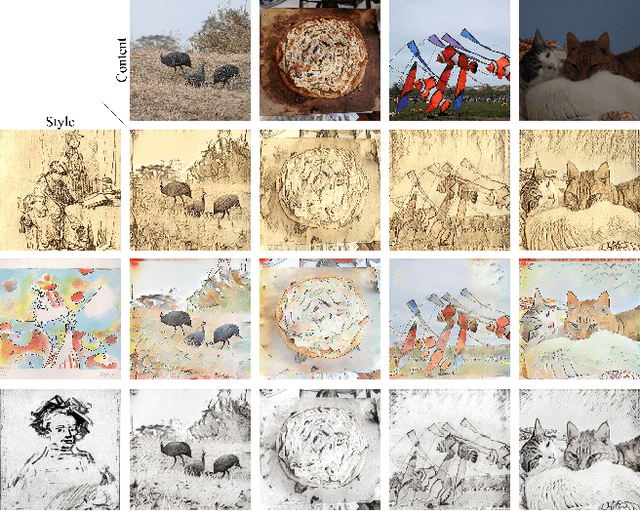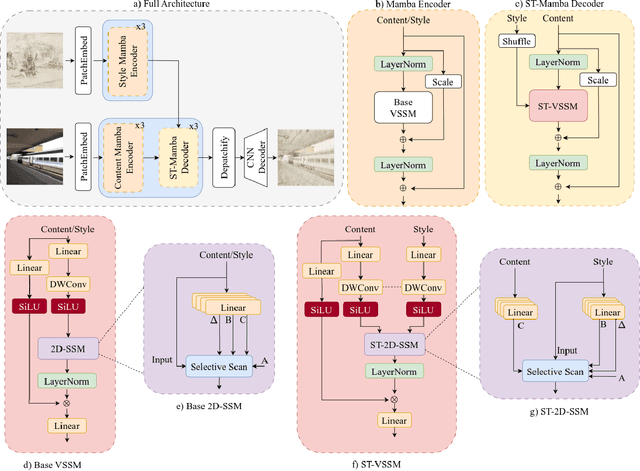Alex Ergasti
U-Shape Mamba: State Space Model for faster diffusion
Apr 18, 2025Abstract:Diffusion models have become the most popular approach for high-quality image generation, but their high computational cost still remains a significant challenge. To address this problem, we propose U-Shape Mamba (USM), a novel diffusion model that leverages Mamba-based layers within a U-Net-like hierarchical structure. By progressively reducing sequence length in the encoder and restoring it in the decoder through Mamba blocks, USM significantly lowers computational overhead while maintaining strong generative capabilities. Experimental results against Zigma, which is currently the most efficient Mamba-based diffusion model, demonstrate that USM achieves one-third the GFlops, requires less memory and is faster, while outperforming Zigma in image quality. Frechet Inception Distance (FID) is improved by 15.3, 0.84 and 2.7 points on AFHQ, CelebAHQ and COCO datasets, respectively. These findings highlight USM as a highly efficient and scalable solution for diffusion-based generative models, making high-quality image synthesis more accessible to the research community while reducing computational costs.
$^R$FLAV: Rolling Flow matching for infinite Audio Video generation
Mar 12, 2025Abstract:Joint audio-video (AV) generation is still a significant challenge in generative AI, primarily due to three critical requirements: quality of the generated samples, seamless multimodal synchronization and temporal coherence, with audio tracks that match the visual data and vice versa, and limitless video duration. In this paper, we present $^R$-FLAV, a novel transformer-based architecture that addresses all the key challenges of AV generation. We explore three distinct cross modality interaction modules, with our lightweight temporal fusion module emerging as the most effective and computationally efficient approach for aligning audio and visual modalities. Our experimental results demonstrate that $^R$-FLAV outperforms existing state-of-the-art models in multimodal AV generation tasks. Our code and checkpoints are available at https://github.com/ErgastiAlex/R-FLAV.
Mamba-ST: State Space Model for Efficient Style Transfer
Sep 16, 2024



Abstract:The goal of style transfer is, given a content image and a style source, generating a new image preserving the content but with the artistic representation of the style source. Most of the state-of-the-art architectures use transformers or diffusion-based models to perform this task, despite the heavy computational burden that they require. In particular, transformers use self- and cross-attention layers which have large memory footprint, while diffusion models require high inference time. To overcome the above, this paper explores a novel design of Mamba, an emergent State-Space Model (SSM), called Mamba-ST, to perform style transfer. To do so, we adapt Mamba linear equation to simulate the behavior of cross-attention layers, which are able to combine two separate embeddings into a single output, but drastically reducing memory usage and time complexity. We modified the Mamba's inner equations so to accept inputs from, and combine, two separate data streams. To the best of our knowledge, this is the first attempt to adapt the equations of SSMs to a vision task like style transfer without requiring any other module like cross-attention or custom normalization layers. An extensive set of experiments demonstrates the superiority and efficiency of our method in performing style transfer compared to transformers and diffusion models. Results show improved quality in terms of both ArtFID and FID metrics. Code is available at https://github.com/FilippoBotti/MambaST.
MARS: Paying more attention to visual attributes for text-based person search
Jul 05, 2024Abstract:Text-based person search (TBPS) is a problem that gained significant interest within the research community. The task is that of retrieving one or more images of a specific individual based on a textual description. The multi-modal nature of the task requires learning representations that bridge text and image data within a shared latent space. Existing TBPS systems face two major challenges. One is defined as inter-identity noise that is due to the inherent vagueness and imprecision of text descriptions and it indicates how descriptions of visual attributes can be generally associated to different people; the other is the intra-identity variations, which are all those nuisances e.g. pose, illumination, that can alter the visual appearance of the same textual attributes for a given subject. To address these issues, this paper presents a novel TBPS architecture named MARS (Mae-Attribute-Relation-Sensitive), which enhances current state-of-the-art models by introducing two key components: a Visual Reconstruction Loss and an Attribute Loss. The former employs a Masked AutoEncoder trained to reconstruct randomly masked image patches with the aid of the textual description. In doing so the model is encouraged to learn more expressive representations and textual-visual relations in the latent space. The Attribute Loss, instead, balances the contribution of different types of attributes, defined as adjective-noun chunks of text. This loss ensures that every attribute is taken into consideration in the person retrieval process. Extensive experiments on three commonly used datasets, namely CUHK-PEDES, ICFG-PEDES, and RSTPReid, report performance improvements, with significant gains in the mean Average Precision (mAP) metric w.r.t. the current state of the art.
Towards Controllable Face Generation with Semantic Latent Diffusion Models
Mar 19, 2024Abstract:Semantic Image Synthesis (SIS) is among the most popular and effective techniques in the field of face generation and editing, thanks to its good generation quality and the versatility is brings along. Recent works attempted to go beyond the standard GAN-based framework, and started to explore Diffusion Models (DMs) for this task as these stand out with respect to GANs in terms of both quality and diversity. On the other hand, DMs lack in fine-grained controllability and reproducibility. To address that, in this paper we propose a SIS framework based on a novel Latent Diffusion Model architecture for human face generation and editing that is both able to reproduce and manipulate a real reference image and generate diversity-driven results. The proposed system utilizes both SPADE normalization and cross-attention layers to merge shape and style information and, by doing so, allows for a precise control over each of the semantic parts of the human face. This was not possible with previous methods in the state of the art. Finally, we performed an extensive set of experiments to prove that our model surpasses current state of the art, both qualitatively and quantitatively.
 Add to Chrome
Add to Chrome Add to Firefox
Add to Firefox Add to Edge
Add to Edge